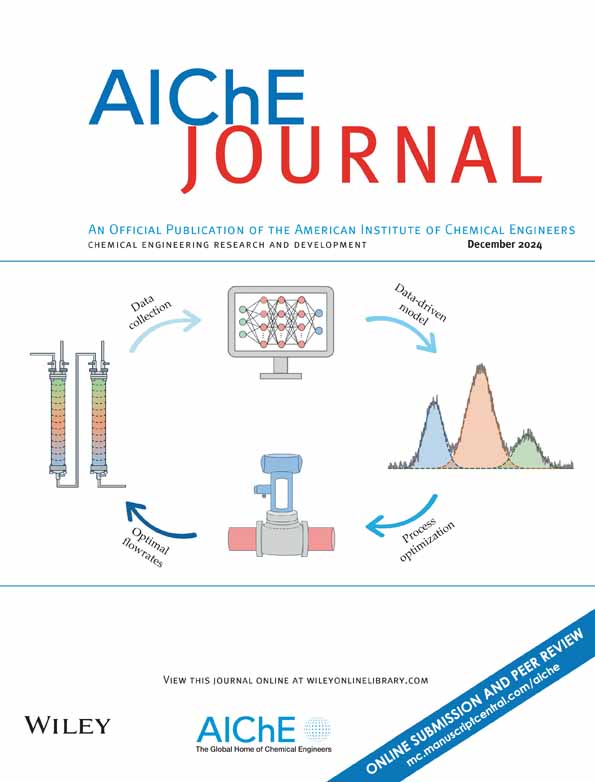Advancing efficient green CO2 capture with hydrothermally recyclable Zr(HPO4)2 catalysts: Experimental and DFT insights
IF 3.5
3区 工程技术
Q2 ENGINEERING, CHEMICAL
引用次数: 0
Abstract
Catalytic amine–based solution regeneration has attracted considerable attention due to its potential to reduce energy consumption in carbon dioxide (CO2) separation. However, the limited catalytic activity and cycling stability of catalysts under high–temperature alkaline conditions hinder their industrial application. Herein, zirconium hydrogenphosphate (ZrHP) catalysts, featuring abundant acidic sites, were first utilized for amine solution regeneration. By leveraging its proton donation and acceptance mechanism, efficient monoethanolamine solution regeneration was achieved. The ZrHP–4 catalyst demonstrated a 526% increase in the instantaneous CO2 desorption rate compared to the non–catalytic test, reducing the relative heat duty by 48%. Moreover, ZrHP–4 exhibited remarkable stability over 10 cycles without requiring regeneration. Density functional theory calculations revealed that ZrHP promotes CO2 desorption by elongating the C—N bond of carbamate and lowering the proton transfer energy barrier. Therefore, this study offers novel insights into the design and mechanistic understanding of efficient and stable catalysts for amine solution regeneration.利用水热可回收的Zr(HPO4)2催化剂推进高效的绿色二氧化碳捕集:实验和DFT见解
催化胺基溶液再生由于具有降低二氧化碳(CO2)分离能耗的潜力而受到广泛关注。然而,催化剂在高温碱性条件下有限的催化活性和循环稳定性阻碍了其工业应用。本文首次将磷酸氢锆(ZrHP)催化剂用于胺溶液再生,该催化剂具有丰富的酸性位点。利用其质子捐赠和接受机制,实现了高效的单乙醇胺溶液再生。与非催化测试相比,ZrHP-4催化剂的瞬时CO2解吸率提高了526%,相对热负荷降低了48%。此外,ZrHP-4在10次循环中表现出显著的稳定性,无需再生。密度泛函理论计算表明,ZrHP通过延长氨基甲酸酯的C-N键和降低质子转移能垒来促进CO2的脱附。因此,本研究为高效稳定的胺溶液再生催化剂的设计和机理理解提供了新的见解。
本文章由计算机程序翻译,如有差异,请以英文原文为准。
求助全文
约1分钟内获得全文
求助全文
来源期刊

AIChE Journal
工程技术-工程:化工
CiteScore
7.10
自引率
10.80%
发文量
411
审稿时长
3.6 months
期刊介绍:
The AIChE Journal is the premier research monthly in chemical engineering and related fields. This peer-reviewed and broad-based journal reports on the most important and latest technological advances in core areas of chemical engineering as well as in other relevant engineering disciplines. To keep abreast with the progressive outlook of the profession, the Journal has been expanding the scope of its editorial contents to include such fast developing areas as biotechnology, electrochemical engineering, and environmental engineering.
The AIChE Journal is indeed the global communications vehicle for the world-renowned researchers to exchange top-notch research findings with one another. Subscribing to the AIChE Journal is like having immediate access to nine topical journals in the field.
Articles are categorized according to the following topical areas:
Biomolecular Engineering, Bioengineering, Biochemicals, Biofuels, and Food
Inorganic Materials: Synthesis and Processing
Particle Technology and Fluidization
Process Systems Engineering
Reaction Engineering, Kinetics and Catalysis
Separations: Materials, Devices and Processes
Soft Materials: Synthesis, Processing and Products
Thermodynamics and Molecular-Scale Phenomena
Transport Phenomena and Fluid Mechanics.
 求助内容:
求助内容: 应助结果提醒方式:
应助结果提醒方式:


